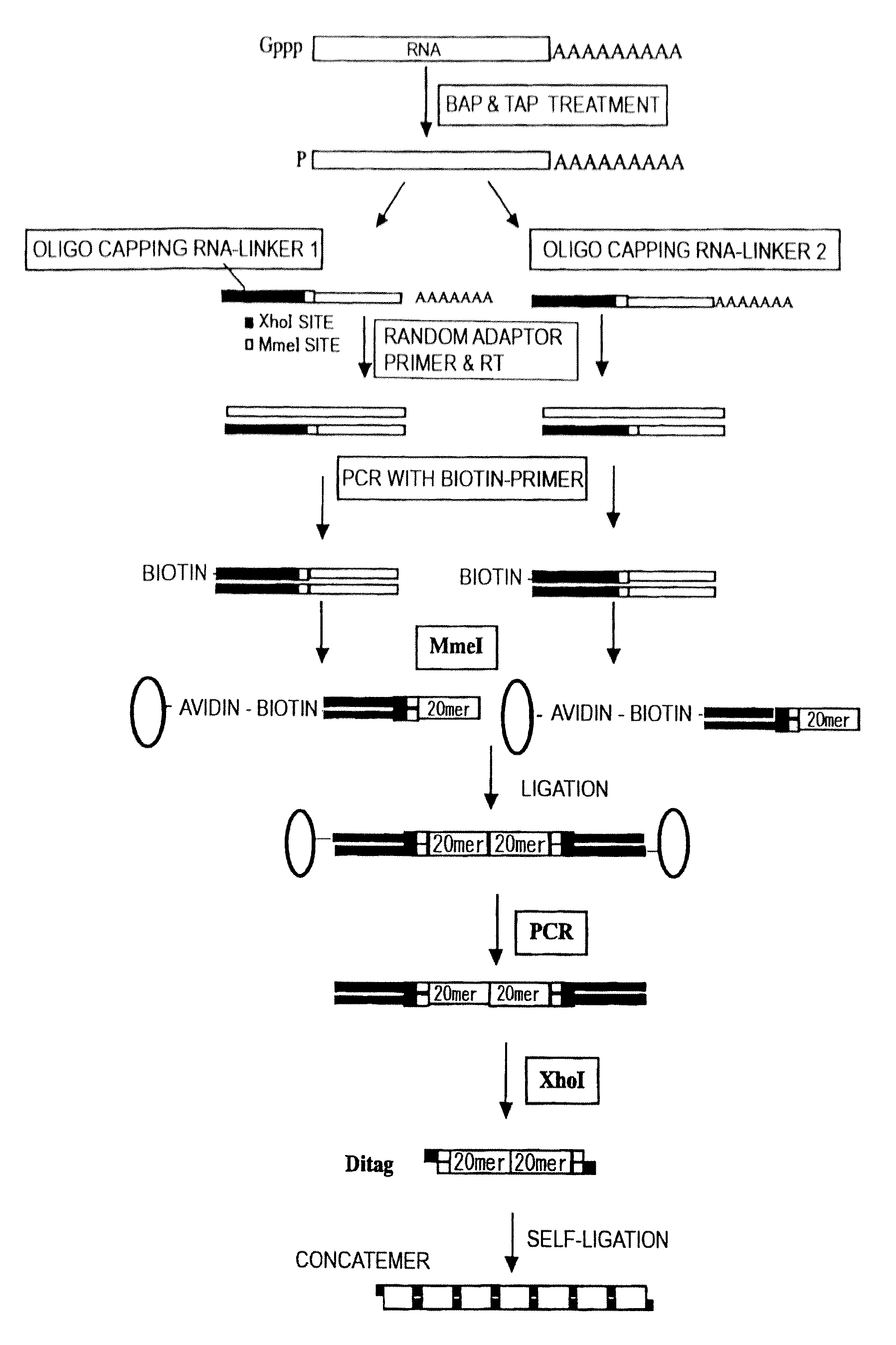Methods for Obtaining Gene Tags
a gene tag and gene technology, applied in the field of gene tags, can solve the problems of generating no tag for cdna without such a restriction enzyme recognition sequence, and the relationship between the nucleotide sequence of the tag and the full-length cdna sequence remains to be solved, so as to achieve clear cellular functions at the protein level, facilitate transcriptional start sites, and high degree of completeness
- Summary
- Abstract
- Description
- Claims
- Application Information
AI Technical Summary
Benefits of technology
Problems solved by technology
Method used
Image
Examples
example 1
[0202]In this example, it was confirmed that gene tags including a nucleotide sequence from the 5′ end of mRNA can be obtained by carrying out the experiment described below in accordance with the present invention. The procedure described below is summarized in FIG. 1.
Oligo-Capping Method
[0203]An oligo-capping method modified from the method of Maruyama and Sugano (Maruyama, K., Sugano, S., 1994. Oligo-capping: a simple method to replace the cap structure of eukaryotic mRNAs with oligoribo-nucleotides. Gene 138, 171-174.) was used. 5 to 10 μg of poly(A)+ RNA was treated with 1.2 unit of bacterial alkaline phosphatase (BAP; TaKaRa) in 100 μl of a mixture containing 100 mM Tris-HCl (pH 8.0), 5 mM 2-mercaptoethanol, and 100 units of RNasin (Promega) at 37° C. for 40 minutes. After extraction with phenol:chloroform (1:1) twice and ethanol precipitation, the poly(A)+ RNA was treated with 20 units of tobacco acid pyrophosphatase (TAP) in 100 μl of a mixture containing 50 mM sodium acetat...
example 2
[0226]Results obtained by gene expression analysis using gene tags including the nucleotide sequence from the 5′ end of mRNA according to the present invention (hereinafter referred to as “5′ SAGE”) were compared with those obtained by conventional SAGE (hereinafter referred to as “3′ SAGE”).
Materials and Methods
Generation of 3′-Long SAGE Library
[0227]Total RNA was isolated from HEK293 and mRNA was selected as previously described (Hashimoto, S.-i., Suzuki, T., Dong, H.-Y., Yamazaki, N. & Matsushima, K. Serial analysis of gene expression in human monocytes and macrophages. Blood 94, 837-844, 1999). Long SAGE (Saha, S. et al. Using the transcriptome to annotate the genome. Nat Biotechnol 20, 508-512, 2002) was performed with 3 μg mRNA using the standard SAGE protocol with the following modifications.
[0228]After NlaIII digestion, linker 1A (5′-TTT GGA TTT GCT GGT GCA GTA CAA CTA GGC TTA ATA TCC GAC ATG-3′ / SEQ ID NO: 40) and linker 1B (5′-TCG GAT ATT AAG CCT AGT TGT ACT GCA CCA GCA AAT...
PUM
| Property | Measurement | Unit |
|---|---|---|
| Length | aaaaa | aaaaa |
| Frequency | aaaaa | aaaaa |
| Gene expression profile | aaaaa | aaaaa |
Abstract
Description
Claims
Application Information
 Login to View More
Login to View More - R&D
- Intellectual Property
- Life Sciences
- Materials
- Tech Scout
- Unparalleled Data Quality
- Higher Quality Content
- 60% Fewer Hallucinations
Browse by: Latest US Patents, China's latest patents, Technical Efficacy Thesaurus, Application Domain, Technology Topic, Popular Technical Reports.
© 2025 PatSnap. All rights reserved.Legal|Privacy policy|Modern Slavery Act Transparency Statement|Sitemap|About US| Contact US: help@patsnap.com



